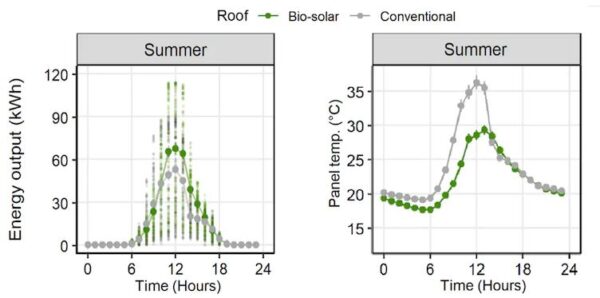A study, led by researchers from the University of Technology in Sydney, suggests that a ‘biosolar’ rooftop system – one that combines a solar system installed on a roof that is partially or completely covered with vegetation – provides significant improvements in panel efficiency and energy production.
“As solar panels heat up beyond 25℃, their efficiency decreases markedly,” the researchers said. “Green roofs moderate rooftop temperatures so we wanted to find out could green roofs help with the problem of heat reducing the output of solar panels.”
The research team, which also included academics from the University of Canberra and Charles Sturt University, compared a conventional rooftop PV system with a combined solar and integrated green roof system over an eight-month period that spanned summer and winter.
The two buildings used in the study are the same height, size, and shape and are located next to each other in Sydney’s central business district. Both rooftops encompass about 1,860 m2, with about one third covered by solar panels. Vegetation covered about 78% of the green roof and the solar panels covered 40% of this planted area.
Both the green and conventional rooftop systems employed four SolarEdge three-phase inverters rated to operate at 98 % efficiency. The green roof comprised 335 SunPower Maxeon 395 W panels, with a total system size of 132.33 kW. The conventional roof used 346 LG 320 W panels with a peak nominal power of 110.72 kW.
“We measured the impacts on biodiversity and solar output, as well as how the plants coped with having panels installed above them,” the researchers said, noting that the green roof had reduced surface temperatures by up to 9.63 C for the solar panels and 6.93 C for the roof surfaces.

The research team said the reduction in temperature had delivered significant improvements in solar panel efficiency which led to increased solar generation and overall energy production.
“This lowering of temperatures increased the maximum output of the solar panels by 21-107%, depending on the month,” they said. “Performance modeling indicates an extensive green roof in central Sydney can, on average, produce 4.5% more electricity at any given light level.”
The researchers said the benefits of combing solar panels with a living roof extended beyond increased energy production with the vegetation on the biosolar roof flourishing in the areas directly below and surrounding the solar panels.
“This was surprising,” they said. “It was not expected the plants would prefer the shaded areas under the panels to the open areas. This shows that shading by solar panels will not prevent the growth of full and healthy roof gardens.”
The green roof also supported more species of birds and insects than the conventional roof, decreased stormwater runoff, and insulated the building from extremes of temperature.
Another research group led by the Netherlands' KWR Water Research Institute recently investigated how a blue-green roof (BGR) may act as a cooling agent for rooftop PV systems and has found that this kind of roof may lower the roof surface temperature by up to 4.64 C compared to a conventional bitumen roof (BiR).
This content is protected by copyright and may not be reused. If you want to cooperate with us and would like to reuse some of our content, please contact: editors@pv-magazine.com.




1 comment
By submitting this form you agree to pv magazine using your data for the purposes of publishing your comment.
Your personal data will only be disclosed or otherwise transmitted to third parties for the purposes of spam filtering or if this is necessary for technical maintenance of the website. Any other transfer to third parties will not take place unless this is justified on the basis of applicable data protection regulations or if pv magazine is legally obliged to do so.
You may revoke this consent at any time with effect for the future, in which case your personal data will be deleted immediately. Otherwise, your data will be deleted if pv magazine has processed your request or the purpose of data storage is fulfilled.
Further information on data privacy can be found in our Data Protection Policy.